Looking to start A/B testing but don’t know where to begin? Here’s a quick guide to the best beginner-friendly tools in 2025. These platforms simplify testing with no-code editors, automated analytics, and templates, making it easy for non-technical users to run experiments. Whether you’re optimizing websites, landing pages, or email campaigns, there’s a tool for you.
Key Tools at a Glance:
- VWO: Free for small websites, drag-and-drop editor, AI-powered insights.
- AB Tasty: Enterprise-level, AI traffic allocation, omnichannel testing.
- Convert: Privacy-focused, compliance automation, easy setup.
- Unbounce: Best for landing pages, AI-driven optimization, $99/month.
- OptiBase: AI suggestions, tailored for entry-level teams.
- Crazy Egg: Heatmaps, session recordings, $29/month.
- Brevo: Email campaign testing, free tier available.
Quick Comparison Table:
| Tool | Key Features | Starting Price | Best For |
|---|---|---|---|
| VWO | Visual editor, AI insights | Free (10k users) | Website testing |
| AB Tasty | Omnichannel, AI traffic | $60k/year | Enterprise teams |
| Convert | Compliance tools, no code | Contact Sales | Regulated industries |
| Unbounce | Landing page optimization | $99/month | Landing pages |
| Crazy Egg | Visual analytics, heatmaps | $29/month | Visual data insights |
| Brevo | Email A/B testing | Free tier | Email campaigns |
Start with tools like VWO or Unbounce for ease of use, or explore advanced options like AB Tasty for enterprise needs. Choose based on your goals, budget, and testing priorities.
Top A/B Testing Tools for Marketers in 2025
Benefits of Simple A/B Testing Tools
Modern A/B testing tools make it easier to experiment without needing advanced technical skills. They do this through features like visual editors for code-free changes, automated analytics for easier data interpretation, and pre-built templates to speed up testing. These features are the backbone of today’s A/B testing platforms.
With visual editors, such as VWO’s WYSIWYG interface, marketers can tweak page elements without writing a single line of code [1][4]. Think of it as building with Lego blocks – straightforward and marketer-friendly.
Automated analytics have also made understanding test results much easier. For example, Convert’s platform offers real-time, color-coded dashboards [9]. This eliminates the need to dive into complex statistical calculations.
Pre-built templates are another game-changer. Common elements like countdown timers and pop-ups come ready to use, cutting down the time it takes to go from idea to execution.
Integrations are a big plus, too. Many tools now offer one-click CMS connections and visual workflow builders. For instance, AB Tasty’s HubSpot connector doesn’t require any coding, making it perfect for beginners who want to link tools without relying on IT support.
"Intuitive UIs that make statistical testing approachable" – Chloe O’Keeffe on AB Tasty [9]
For newcomers, these features make onboarding smoother – a key consideration in the tools we’ve highlighted.
1. AB Tasty
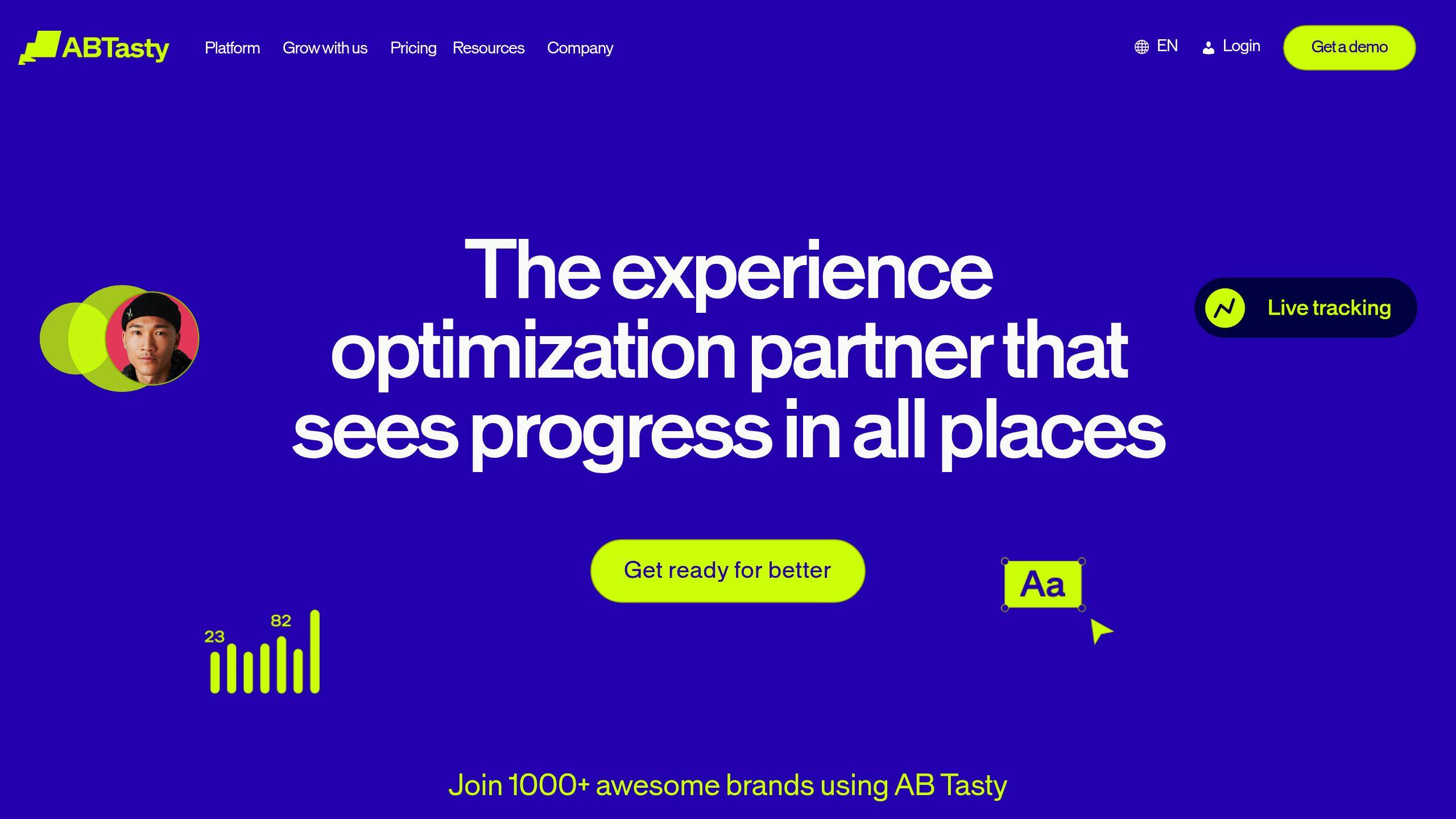
Pricing and Free Trial Availability
AB Tasty’s pricing starts at around $60,000 per year, tailored to each client’s needs. While there’s no free trial, the platform offers personalized demos to help businesses determine if it’s the right fit for them [2][5][8]. Despite its enterprise-level cost, the user-friendly interface makes complex testing more approachable.
Beginner-Friendliness (Ease of Use)
AB Tasty is designed with marketing teams in mind, offering an accessible experience. However, advanced tools like behavioral targeting may require some initial training to fully utilize.
Key Features
AB Tasty stands out with several advanced tools:
- AI-powered insights to identify testing opportunities and top-performing variations [8]
- Automatic traffic allocation to optimize test results [7]
- Cross-page journey testing for more comprehensive experiments [5]
Best Use Case
This platform is especially effective for e-commerce businesses and content-driven websites [7][8]. Its strong omnichannel testing capabilities make it a great choice for marketers managing experiments across multiple customer touchpoints [1][5]. For example, an online retailer can simultaneously test product pages, checkout processes, and email campaigns.
Clients also benefit from a dedicated customer success manager to guide them through strategic testing, making AB Tasty a solid option for enterprise-level beginners [2][5].
2. VWO (Visual Website Optimizer)
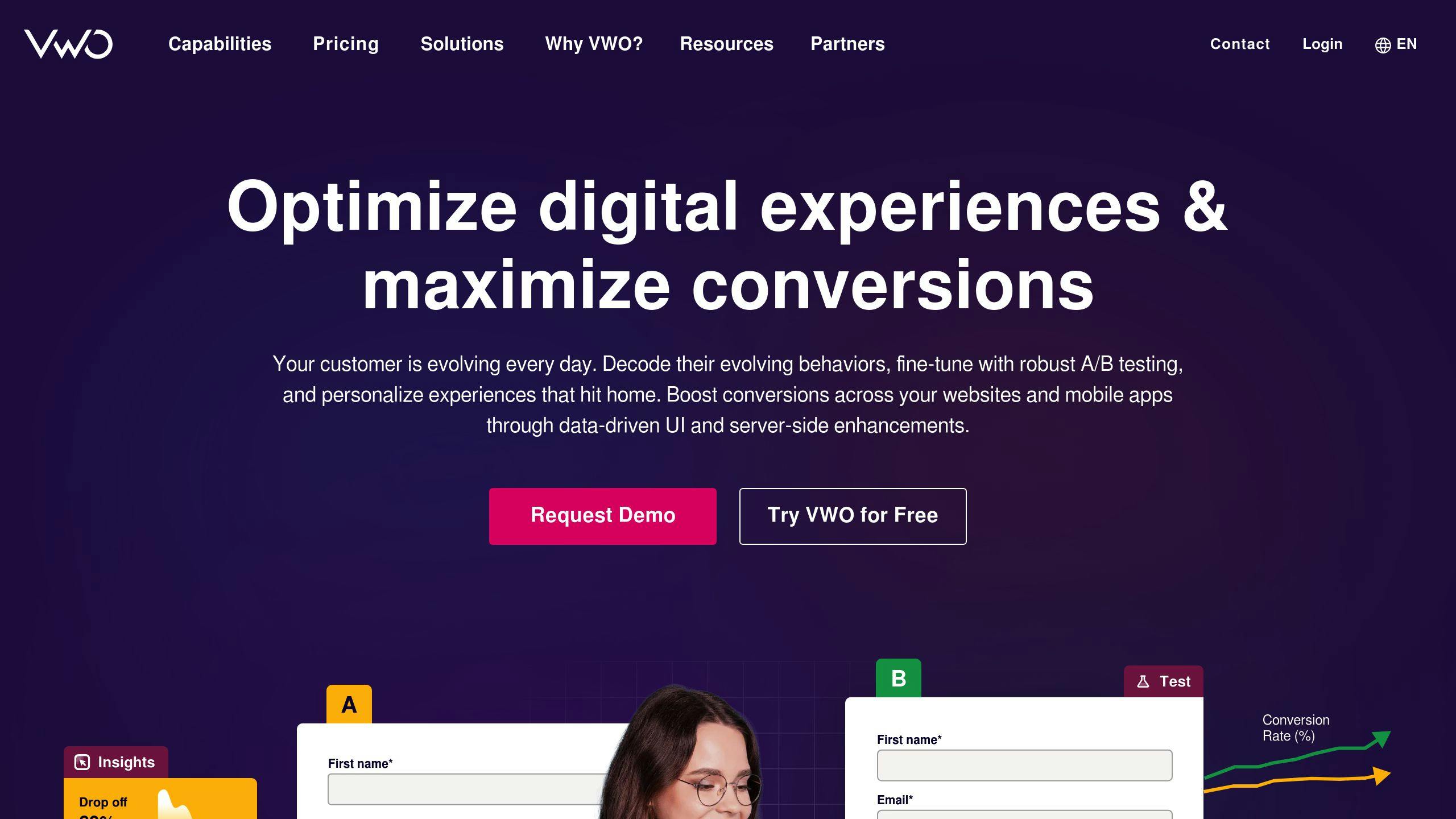
Pricing and Free Trial Availability
VWO provides a free plan for websites with up to 10,000 monthly users, alongside paid options starting at $314 per month. All plans include a 30-day trial, making it easier for users to explore the platform’s features before committing [3] [6].
Beginner-Friendliness (Ease of Use)
VWO is designed with non-technical users in mind. Its drag-and-drop editor allows you to make quick changes to website elements without coding [1] [4]. The platform also offers a unified dashboard that displays key insights like heatmaps, session recordings, and conversion funnels, ensuring all essential data is easily accessible [1] [6].
Standout Features
VWO offers several features that set it apart:
- AI-Powered Testing: The platform uses generative AI to analyze your site and suggest test ideas, addressing the common hurdle of deciding what to test first [1].
- Omnichannel Testing: It supports experiments across both web and mobile apps, all managed from a single interface [1].
- Adobe Integration: Seamless compatibility with Adobe Experience Cloud makes it a great choice for businesses already using Adobe’s tools [1] [6].
Best Use Case
VWO is particularly well-suited for small to medium-sized businesses that need a robust testing platform but lack dedicated development teams [4]. It’s especially effective for e-commerce businesses aiming to optimize product pages and checkout processes [3] [6].
Another key strength is its built-in compliance tools, making it a reliable option for businesses in regulated industries [8]. VWO can handle everything from basic A/B tests to more advanced, multi-page experiments, all with a relatively short learning curve [3] [9].
3. Convert
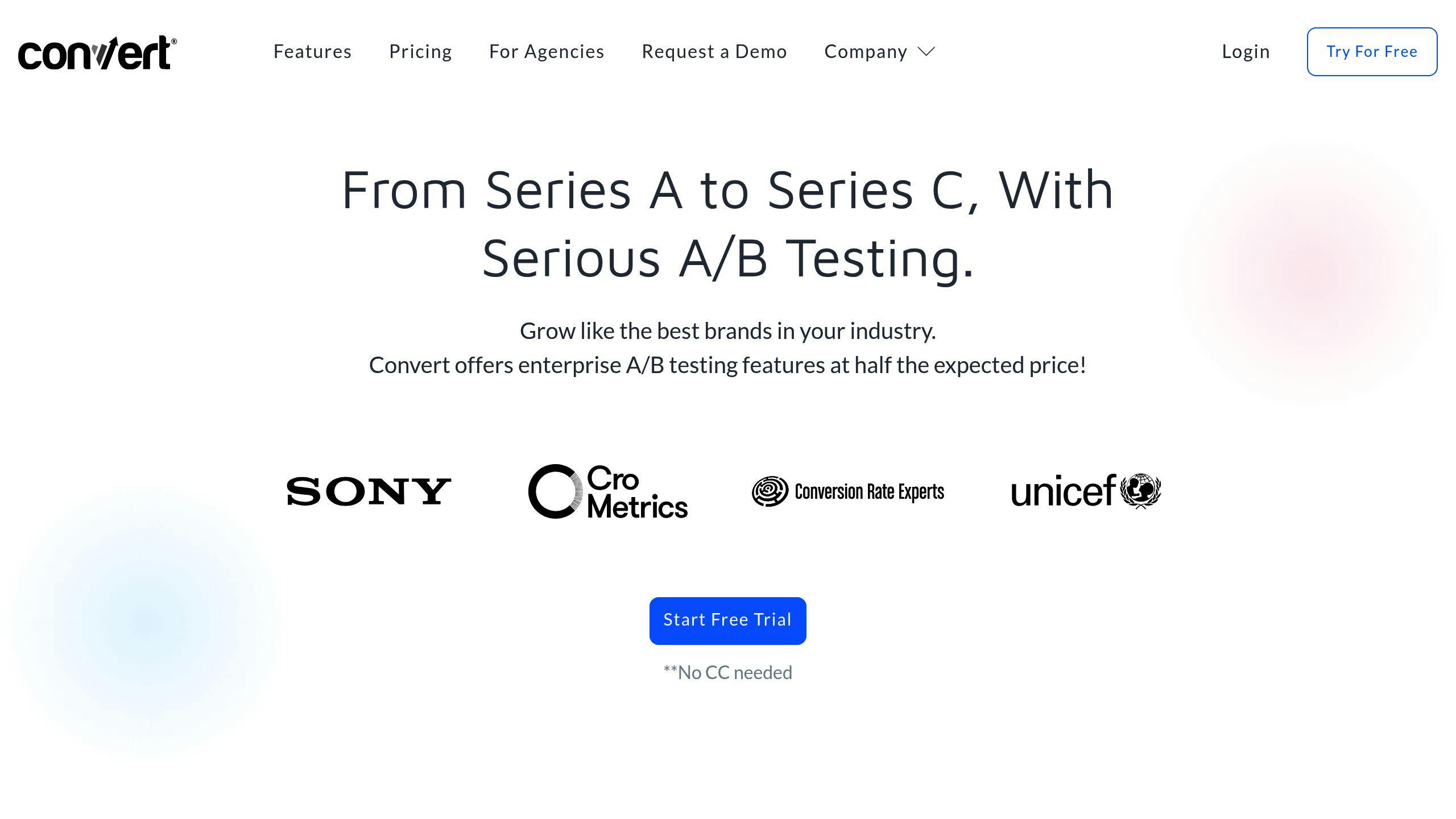
Pricing and Free Trial Availability
Convert offers experimentation solutions tailored for regulated industries. Pricing is customized for each enterprise, so you’ll need to contact their sales team for a quote. They also provide free trials upon request.
Beginner-Friendliness (Ease of Use)
Convert is designed to make A/B testing straightforward for non-technical users. Its visual editor allows you to create tests without needing any coding skills. A major highlight is its built-in tools for compliance automation, which ensure privacy standards are met – especially useful for businesses in regulated sectors like finance or healthcare.
Key Features
Here are some of Convert’s standout capabilities:
- Privacy-Focused Design: Automatically updates regulations and monitors compliance.
- Smart Traffic Allocation: Uses machine learning to optimize test traffic based on performance, similar to AB Tasty’s AI-driven insights.
Best Use Case
Convert works best for beginner teams in industries like finance or healthcare that require straightforward compliance tools. It’s particularly effective for businesses that need to:
- Conduct tests across multiple domains.
- Automatically stay compliant with data protection rules.
- Expand testing programs without adding technical complexity.
- Perform technical experiments without writing code.
4. Unbounce
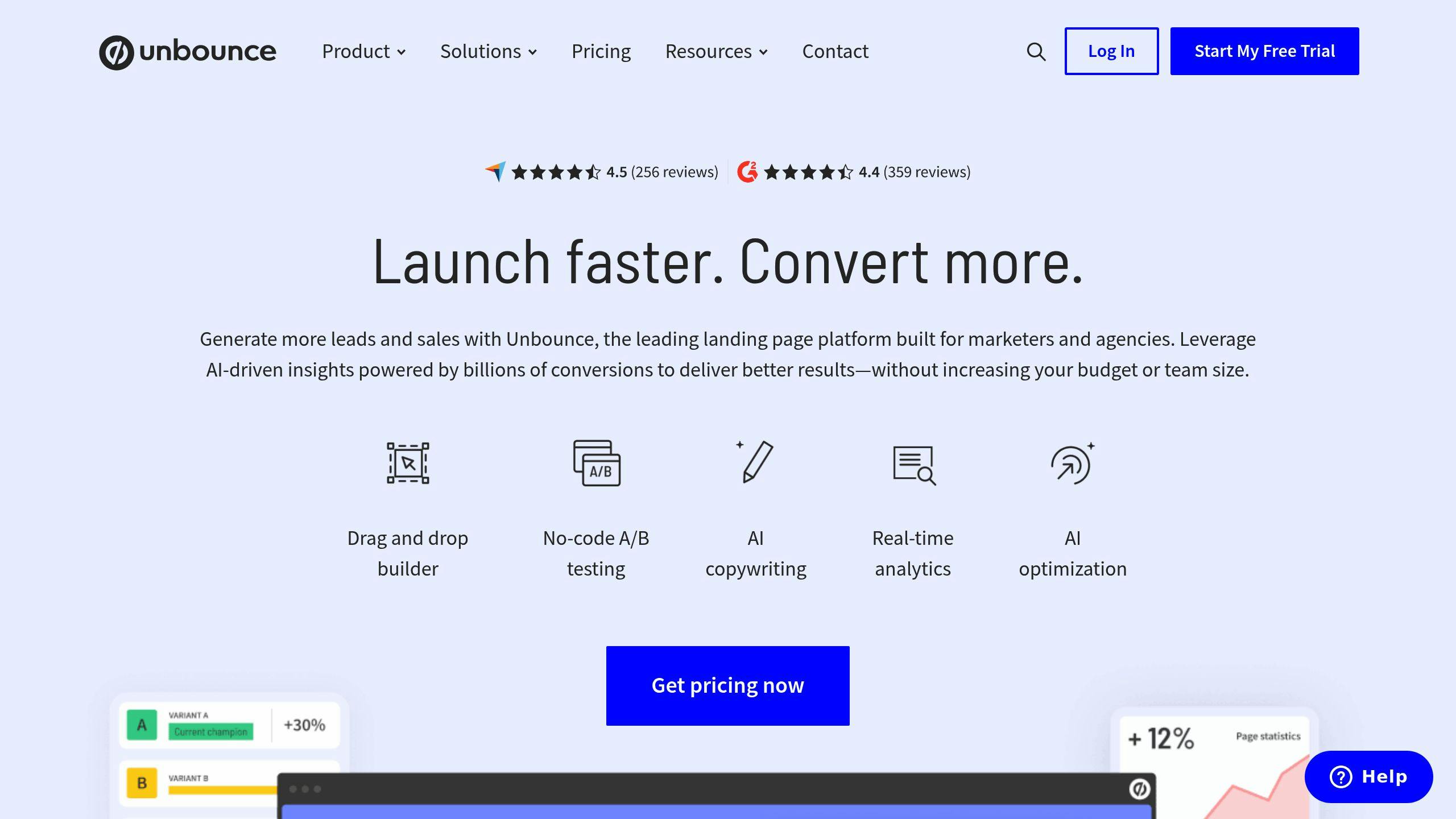
Pricing and Free Trial Availability
Unbounce provides a straightforward pricing model with a 14-day free trial, allowing users to test unlimited variations. The Essential plan starts at $99/month and includes full A/B testing capabilities, making it a solid option for those new to optimization [7].
Beginner-Friendliness (Ease of Use)
If your focus is testing landing pages, Unbounce is a time-saver. It requires minimal training compared to other platforms [4]. With over 100 mobile-responsive templates and a drag-and-drop editor, you can create pages without any coding skills [1].
Standout Features
Unbounce’s AI-driven tools elevate it beyond standard testing platforms:
- Smart Traffic: This feature automatically directs visitors to the best-performing variations. It also uses AI to recommend ideal element placements based on historical data, cutting test setup time by 65% [7].
- Conversion Optimization: Smart Traffic goes beyond traditional split testing by automating the optimization process, leading to better conversion rates [1][7].
Best Use Case
Unbounce shines in landing page optimization, especially with its smooth integrations with platforms like WordPress and Shopify, which are common in beginner setups [7]. Marketing teams looking to move past basic tools will appreciate its mix of AI-driven speed and user-friendly controls.
New users often see noticeable improvements in conversions thanks to Unbounce’s balance of automation and hands-on customization [7]. Its compatibility with tools like WordPress, Shopify, and Mailchimp – used in 82% of beginner setups – makes it a go-to choice for many [7].
sbb-itb-2ec70df
5. OptiBase
Pricing and Free Trial Availability
OptiBase doesn’t provide upfront pricing details on their website. Instead, you’ll need to contact them directly to get a quote. This likely means their pricing is tailored to fit the unique needs and testing goals of each business.
Beginner-Friendliness (Ease of Use)
Details about OptiBase’s interface aren’t readily available, but the platform emphasizes an easy-to-navigate testing environment. To truly understand its usability, you’ll need to schedule a demo. During this process, their customer success team helps new users with setup and test creation, ensuring a smooth start.
Best Use Case
OptiBase is designed for teams that want to use AI-driven optimization without dealing with complicated setups. It offers machine learning-based insights, automated variation suggestions, and KPI tracking – all without requiring any expertise in data science.
Here are a few things beginners should keep in mind:
- How well it integrates with your existing marketing tools
- The availability of training materials and documentation
- The responsiveness and quality of customer support
OptiBase shines by combining automated AI insights with simple implementation, making it a great choice for marketing teams that are new to A/B testing but eager to explore AI-powered solutions.
6. Crazy Egg
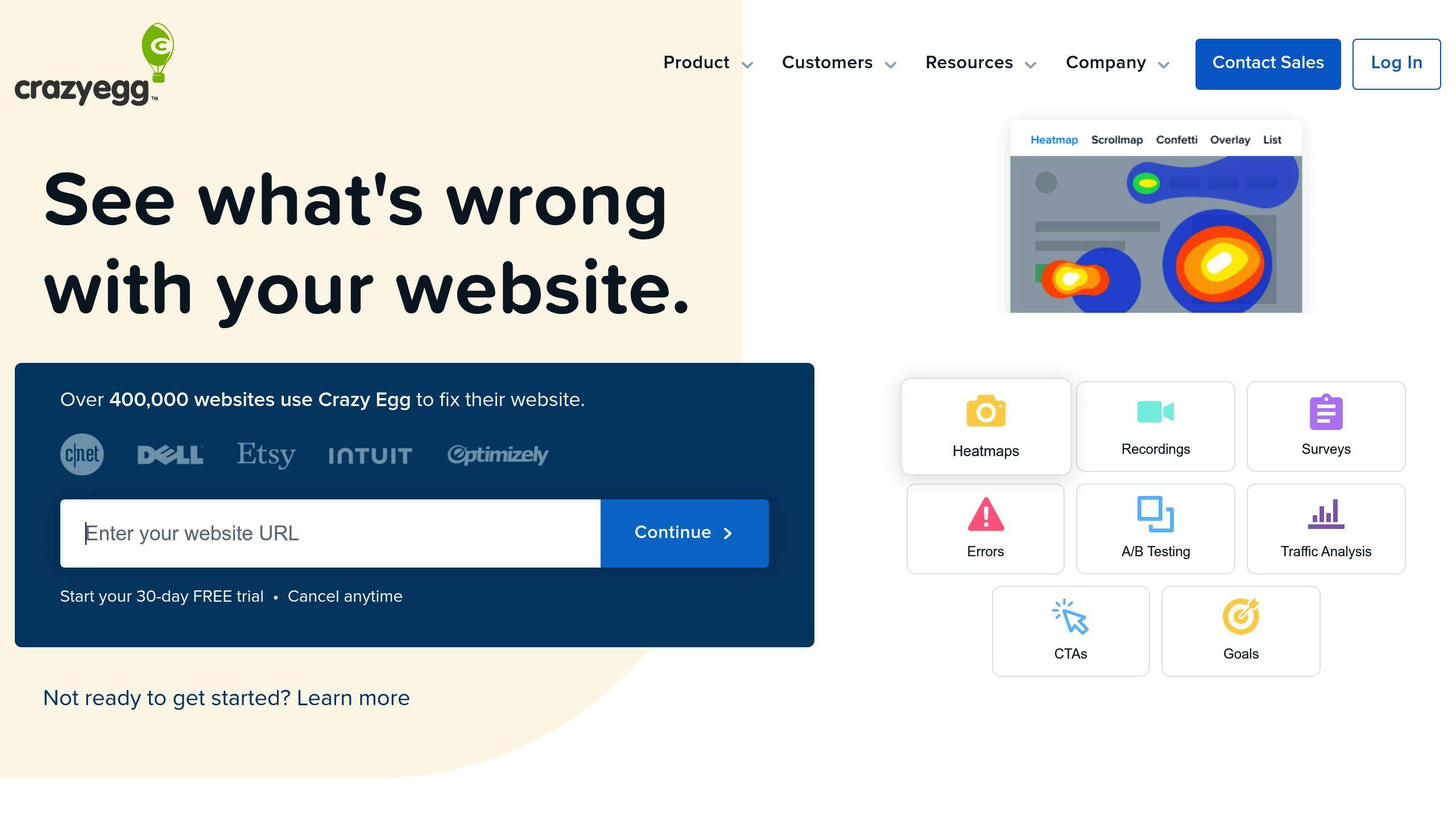
Pricing and Free Trial Availability
Crazy Egg offers custom pricing and includes a free trial, giving users a chance to test its features before committing.
Beginner-Friendliness (Ease of Use)
Crazy Egg is designed with simplicity in mind, making it an excellent option for those new to A/B testing. Its intuitive interface and responsive customer support make it easy to navigate and get assistance when needed.
Standout Features
Crazy Egg stands out for its strong focus on visual data. It combines A/B testing with detailed analytics tools, including:
- Heatmaps that show where users click and scroll
- Session recordings that capture real user interactions
- Conversion funnel visualizations to track how users move through your site
These tools provide a clear picture of user behavior, making it easier to identify what works and what doesn’t.
Best Use Case
Crazy Egg is perfect for anyone looking to combine data-driven testing with visual insights. It’s especially useful for:
- Landing Pages: Fine-tuning CTAs, forms, and other conversion-focused elements
- Content-Heavy Websites: Understanding how users engage with articles, videos, or other media
7. Brevo (formerly Sendinblue)
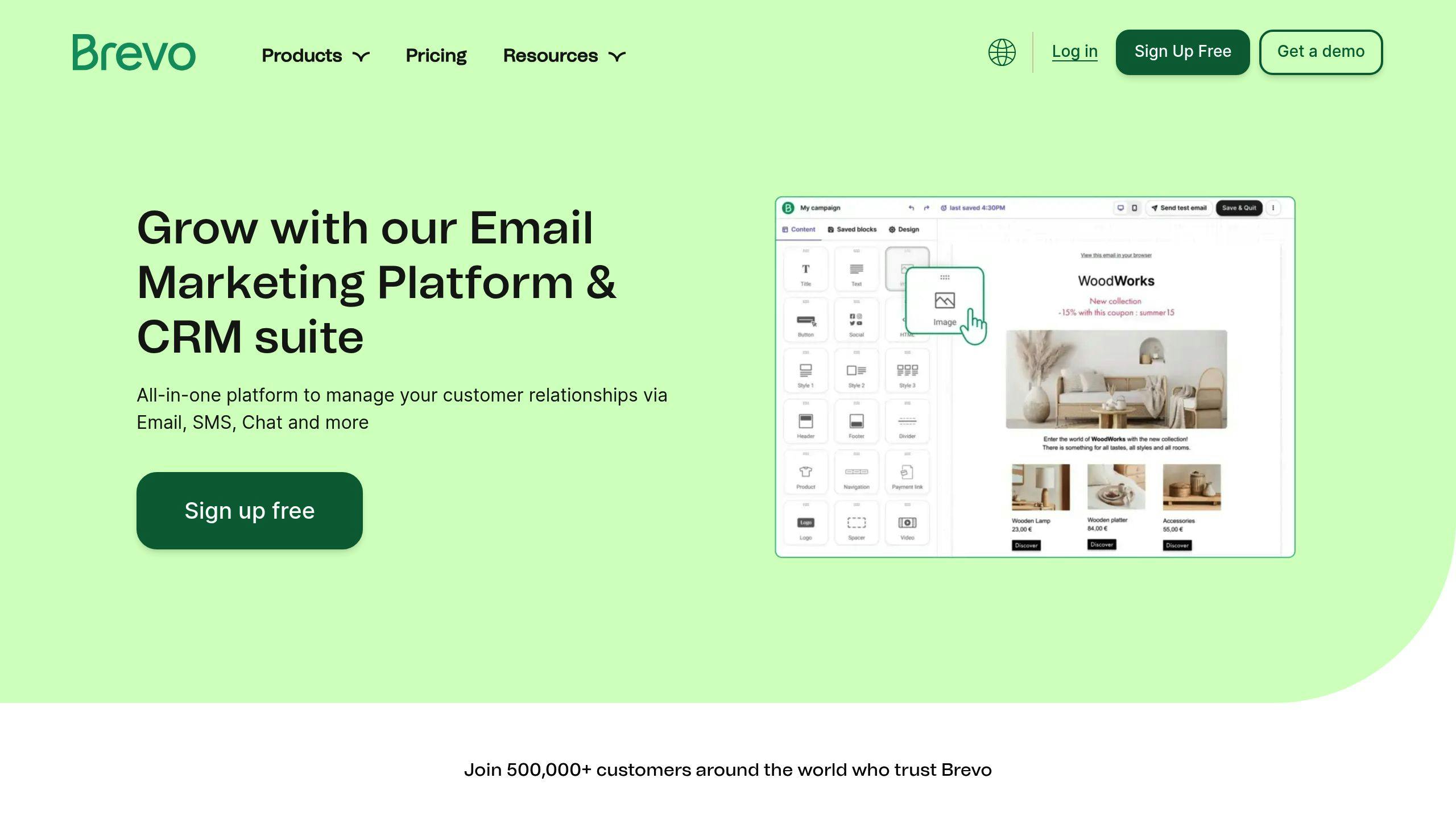
Brevo is a great option for teams zeroing in on email marketing and looking for tools to refine their campaigns.
Beginner-Friendliness (Ease of Use)
This platform is built with simplicity in mind, making it easy to set up A/B tests for email campaigns. It focuses solely on email experimentation and integrates seamlessly with marketing automation workflows that many beginners are already familiar with.
Key Features
Brevo allows users to test various elements of email campaigns, such as subject lines, content, send times, and even sender names. It works smoothly alongside its marketing automation tools, making it a strong choice for those already using Brevo.
Best Fit
Brevo works best for small to medium-sized businesses that prioritize email marketing. It’s particularly useful for:
- Email marketers looking to test subject lines or content.
- Teams leveraging Brevo’s automation tools.
- Basic landing page tests connected to email campaigns.
For businesses with an email-first strategy, Brevo simplifies the process of improving campaigns. It pairs well with tools like Unbounce, which focus more on optimizing web pages.
Tool Features at a Glance
Here’s a quick comparison of some tools and their beginner-friendly features:
| Tool | Key Features (Beginner-Focused) | Starting Price | Best For |
|---|---|---|---|
| VWO | Visual Editor, No-Code Interface, Basic Analytics | Free (up to 10k monthly tracked users) | Website Testing |
| AB Tasty | Widget Library, AI Assistance, Auto-Traffic Allocation | Enterprise ($60k/year) | Enterprise teams needing personalization |
| Convert | Simple Setup, Auto-optimizes traffic allocation | $699/month | Small Business Testing |
| Unbounce | Drag-and-Drop Builder, AI Conversion Boost | $99/month | Landing Pages |
| OptiBase | Basic A/B Testing, Simple Analytics | Contact Sales | Entry-Level Testing |
| Crazy Egg | Heatmaps, Basic A/B Testing | $29/month | Visual Analytics |
| Brevo | Email Testing, Marketing Automation | Free tier available | Email Campaigns |
Pricing reflects 2025 beginner-friendly plans (custom quotes may vary).
VWO and Unbounce stand out for their balance of ease of use and strong features. On the other hand, Crazy Egg and Brevo focus on specific needs like visual analytics and email testing.
For a deeper dive into each tool’s capabilities, check out the detailed reviews above.
Picking the Right Tool
Once you’ve reviewed the core features, it’s time to focus on the factors that will guide your final decision. Use the feature table above as a reference while considering these crucial points.
Budget Alignment
Your budget plays a big role in choosing the right tool. Think about both the upfront costs and how expenses might grow as your testing program expands.
Technical Requirements
If your team doesn’t have developers, look for tools with user-friendly visual editors and no-code interfaces. For example, Unbounce offers a drag-and-drop builder that’s perfect for marketing teams needing quick and easy implementation [1]. On the other hand, if you have technical expertise, advanced tools with API access and server-side options might suit you better.
Here’s a quick guide based on team size and needs:
| Team Size | Recommended Features | Suggested Tools | Why It Fits |
|---|---|---|---|
| Startup (<50 employees) | Visual Editor, Basic Analytics | VWO, Crazy Egg | Affordable and easy to set up |
| SMB (50-500 employees) | Automation, CRM Integration | Convert, Brevo | Balanced features and pricing |
| Established teams | Advanced Security, API Access | AB Tasty, VWO Enterprise | Built for scalability |
Integration Considerations
Check if the tool integrates with the platforms you already use, like Shopify or Google Analytics. Most of the tools mentioned offer these integrations, but it’s always good to double-check.
Support Resources
Think about the level of support your team might need. For example, VWO Enterprise offers 24/7 chat support [6], while tools like Crazy Egg on basic plans only provide email support [7].
Common Pitfalls to Avoid
Don’t pay for features you won’t use. Start with the essential testing capabilities and upgrade only when necessary.
Plan for Scaling
Make sure the tool you choose can grow with you. Look for flexible pricing models that adjust based on your traffic and usage. This will save you from outgrowing your tool too quickly.
Conclusion
Picking the right A/B testing tool as a beginner in 2025 means finding one that fits your needs and your team’s capabilities. Many modern tools combine AI-driven features with user-friendly interfaces. Start by reviewing the feature comparison table, then choose a tool that aligns with your team’s goals and limitations.
Here are some key factors to keep in mind when selecting your platform:
- Technical Requirements: Tools like VWO’s visual editor are designed for teams without coding experience [3][4], making them a great option for non-technical users.
- Budget: Many platforms offer flexible pricing models [2][3][6], so you can begin with a smaller investment and scale as your needs grow.
- Performance: Evaluate how a tool’s features match your testing objectives and your existing technical setup.
If you’re unsure where to start, agencies like Growth-onomics specialize in helping businesses choose and implement the right tools. Their expertise in areas like customer journey mapping and data analytics can ensure your A/B testing efforts support your broader marketing goals.
While these tools offer advanced features that are still beginner-friendly, remember that success in A/B testing depends on more than just the platform. A strong testing strategy and the ability to interpret results are just as important. Whether you’re leveraging Crazy Egg’s visual analytics or AB Tasty’s AI-driven features [5], focus on setting clear goals and extracting actionable insights.
FAQs
What tool should beginners use for A/B testing?
For those starting out in 2025, VWO (Visual Website Optimizer) is a great option. It features a visual editor that doesn’t require coding skills [4] and includes a free tier for up to 10,000 monthly tracked users [3]. Key highlights of VWO include:
- A no-code visual editor and free plan for smaller traffic volumes
- Built-in integration with popular analytics platforms [1]
Which A/B testing tool is the best?
The best tool really depends on your goals and situation. For most beginners, VWO strikes a good balance between features and cost [6]. But if your focus is on landing page optimization, Unbounce could be a better fit [1].
Keep in mind, success in A/B testing goes beyond just picking the right tool. You’ll need clear objectives and a solid strategy. Some important factors to weigh include:
- How easily the tool integrates with your existing systems
- The availability of customer support
- Whether it offers mobile testing features
For more detailed guidance, check out the ‘Picking the Right Tool’ section above. Agencies like Growth-onomics can also assist with selecting and setting up the best tool for your needs.









